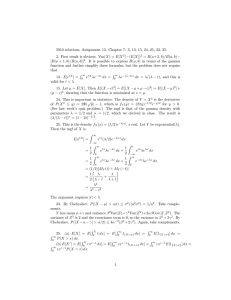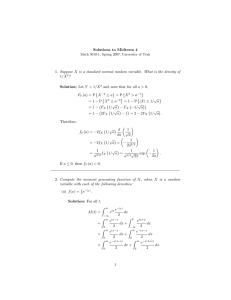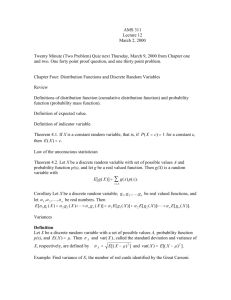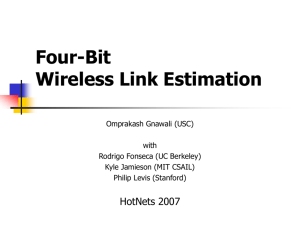Document
advertisement
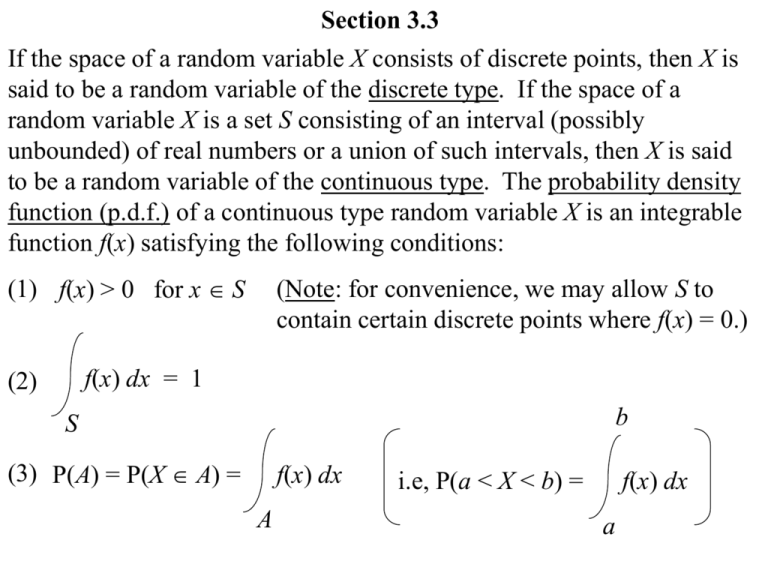
Section 3.3 If the space of a random variable X consists of discrete points, then X is said to be a random variable of the discrete type. If the space of a random variable X is a set S consisting of an interval (possibly unbounded) of real numbers or a union of such intervals, then X is said to be a random variable of the continuous type. The probability density function (p.d.f.) of a continuous type random variable X is an integrable function f(x) satisfying the following conditions: (1) f(x) > 0 for x S (Note: for convenience, we may allow S to contain certain discrete points where f(x) = 0.) f(x) dx = 1 (2) b S (3) P(A) = P(X A) = f(x) dx A i.e, P(a < X < b) = f(x) dx a Suppose X is a continuous-type random variable with outcome space S and p.d.f f(x). x f(x) dx = E(X) = . The mean of X is S The variance of X is (x – )2f(x) dx = E[(X – )2] = S E[X2 – 2X + 2] = E(X2) – 2E(X) + E(2) = E(X2) – 22 + 2 = E(X2) – 2 = 2 = Var(X) . The standard deviation of X is = Var(X) . Recall that for any random variable X, the cumulative distribution x function (c.d.f.) of X is defined to be F(x) = P(X x). If X is a continuous-type random variable, we may write F(x) = f(t) dt The Fundamental Theorem of Calculus implies F /(x) = f(x). – For a continuous-type random variable X with outcome space S and p.d.f f(x), we can define the following: etx f(x) dx The m.g.f. of X (if it exists) is M(t) = E(etX) = S and (just as with discrete-type random variables) M(n)(0) = E(Xn). The (100p)th percentile of the distribution of X, where 0 < p < 1, is defined to be a number p such that F(p) = p. The median of the distribution of X is defined to be 0.5 . The first, second, and third quartiles of the distribution of X are defined to be 0.25 , 0.5 , and 0.75 respectively. 3–y 1. A random variable Y has p.d.f. f(y) = —— if 1 < y < 3 . 2 (1,2) Find each of the following: 1 (a) P(2 < Y < 3) 3 3 3 f(y) dy (3 – y) ——— dy 2 = = 3y y2 — – — 2 4 2 2 3 = 1 — 4 y=2 (b) P(1.5 < Y < 2.5) 2.5 f(y) dy 1.5 2.5 2.5 (3 – y) ——— dy 2 = 1.5 = 3y y2 — – — 2 4 = y = 1.5 1 — 2 (c) P(Y < 2) 2 2 2 f(y) dy – (3 – y) ——— dy 2 = = 3y y2 — – — 2 4 1 y=1 (d) E(Y) – y f(y) dy = 3 — 4 = 1 3 3 (3 – y) y ——— dy 2 (3y – y2) ———— dy = 2 = 1 3 3y2 y3 — – — 4 6 = y=1 5 — 3 (e) Var(Y) E(Y2) = 3 y2 f(y) dy = – y2 (3 – y) ——— dy = 2 1 3 3 (3y2 – y3) ———— dy = 2 3y3 y4 — – — 6 8 1 Var(Y) = = y=1 3 – 5 — 3 2 2 = — 9 3 (f) the m.g.f. (moment generating function) of Y 3 (3 – y) tY ty ty M(t) = E(e ) = e f(y) dy = e ——— dy = 2 – 1 3 3y y2 — – — 2 4 = 1 if t = 0 3 – ————— dy 2 (3ety yety) y=1 = 3 1 3tety – (ytety – ety) ——————— 2t2 e3t – (2t + 1)et = —————— 2t2 y=1 if t 0 (g) the c.d.f. (cumulative distribution function) of Y y F(y) = P(Y y) = f(t) dt = – 0 if y < 1 3y y2 5 = — – — – — 2 4 4 if 1 y < 3 y y (3 – t) ——— dt = 2 3t t2 — – — 2 4 1 t=1 if 3 y 1 1 1/2 1 0 1 2 3 (h) the quartiles of the distribution of Y F(0.25) = P(Y 0.25) = 0.25 3 2 5 — – — – — = 0.25 2 4 4 6 – 2 – 5 = 1 6 – 2 – 6 = 0 2 – 6 + 6 = 0 From the quadratic formula, we find = 3 – 3 1.268 or = 3 + 3 4.732 Considering the space of Y, we see that 0.25 = 3 – 3 1.268 F(0.50) = P(Y 0.50) = 0.5 3 2 5 — – — – — 2 4 4 = 0.5 6 – 2 – 5 = 2 6 – 2 – 7 = 0 2 – 6 + 7 = 0 From the quadratic formula, we find = 3 – 2 1.586 or = 3 + 2 4.414 Considering the space of Y, we see that 0.50 1.586 F(0.75) = P(Y 0.75) = 0.75 3 2 5 — – — – — 2 4 4 = 0.75 6 – 2 – 5 = 3 6 – 2 – 8 = 0 2 – 6 + 8 = 0 From the quadratic formula, we find = 2 or = 4. Considering the space of Y, we see that 0.75 = 2 2. A random variable X has p.d.f. f(x) = Find each of the following: (a) P(–0.5 < X < 0.5) 0.5 0.5 f(x) dx = – 0.5 – 0.5 1 — dx = 6 1/6 if –2 < x < 1 1/2 if 1 x < 2 (1, 1/2) (–2, 1/6) –2 0.5 x 1 — = — 6 6 x = –0.5 1 2 (b) P(X > 0.75) 2 f(x) dx = 0.75 2 1 — dx + 6 1 — dx = 2 f(x) dx = 0.75 1 x — 6 1 0.75 1 2 + x = 0.75 x — 2 x=1 = 1 — 24 + 1 — 2 = 13 — 24 (c) P(0.75 < X < 1.25) 1.25 1 f(x) dx = 0.75 0.75 1.25 1 — dx + 6 1 1 — dx = — 2 6 1 (d) E(X) x f(x) dx – = 1 2 x — dx + 6 x — dx = 2 –2 1 x2 — 12 1 2 + x=–2 x2 — 4 x=1 = –3 — 12 + 3 — 4 = 1 — 2 (e) Var(X) E(X2) = x2 f(x) dx = – –2 1 x3 — 18 1 x2 — dx + 6 2 x2 — dx = 2 1 2 + x=–2 x3 — 6 = 1 — 2 x=1 2 Var(X) = + 5 1 — – — 3 2 17 = — 12 7 — 6 = 5 — 3 (f) the m.g.f. (moment generating function) of X 1 2 tx tx e e M(t) = E(etX) = etx f(x) dx = — dx + — dx = 6 2 – –2 1 1 2 x — 6 x — 2 + x=–2 1 if t = 0 x=1 1 etx — 6t = 2 + x=–2 etx — 2t x=1 3e2t – 2et – e–2t = —————— if t 0 6t (g) the c.d.f. (cumulative distribution function) of X x F(x) = P(X x) = f(t) dt – 0 = x x 1 — dt = 6 –2 1 1 — dt + 6 –2 1 x if x < – 2 t — 6 x+2 = —— if – 2 x < 1 6 t=–2 x 1 1 t — dt = — + — 2 2 2 x = — 2 if 1 x < 2 t=1 1 if 2 x (g) the c.d.f. (cumulative distribution function) of X if x < – 2 0 x F(x) = P(X x) = f(t) dt – = x+2 —— if – 2 x < 1 6 x — 2 if 1 if 2 x 1x<2 1 1/2 2 1 0 1 2 (h) the quartiles of the distribution of X P(X 0.25) = F(0.25) = 0.25 +2 ——– 6 + 2 = 0.25 = 3/2 0.25 = –1/2 Obviously, 0.50 = 1 P(X 0.75) = F(0.75) = 0.75 — = 0.75 2 0.75 = 3/2

